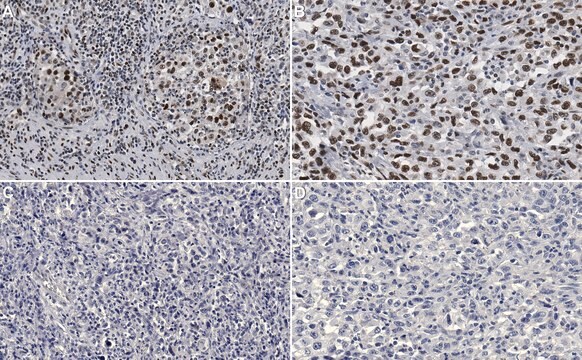06-863
Anti-CREB Antibody
Upstate®, from rabbit
Sinônimo(s):
Cyclic AMP-responsive element-binding protein 1, cAMP-responsive element-binding protein 1, CREB-1
About This Item
Produtos recomendados
fonte biológica
rabbit
Nível de qualidade
forma do anticorpo
purified immunoglobulin
tipo de produto de anticorpo
primary antibodies
clone
polyclonal
purificado por
using Protein A
reatividade de espécies
mouse, human, rat
reatividade da espécie (prevista por homologia)
porcine (based on 100% sequence homology), horse (based on 100% sequence homology), canine (based on 100% sequence homology)
fabricante/nome comercial
Upstate®
técnica(s)
ChIP: suitable (ChIP-seq)
electrophoretic mobility shift assay: suitable
immunoprecipitation (IP): suitable
western blot: suitable
Isotipo
IgG
nº de adesão NCBI
nº de adesão UniProt
Condições de expedição
dry ice
modificação pós-traducional do alvo
unmodified
Informações sobre genes
human ... CREB1(1385)
Descrição geral
Especificidade
Imunogênio
Aplicação
Chromatin Immunoprecipitation (ChIP) Analysis: A representative lot detected an enhanced CREB occupancy at the LYPD3 promoter in LKB1-deficient TE-4 human esophageal cancer cells (Gu, Y., et al. (2012). Oncogene. 31(4):469–479).
Chromatin Immunoprecipitation (ChIP) Analysis: A representative lot detected CREB association at the RNASET2 sites targeted by T-cell Leukemia Virus type 1 (HTLV-1) encoded Tax protein using HTLV-1-infected human T-cell lines, MT-2, C8166/45 and SLB-1 (Polakowski, N., et al. (2011). Viruses. 3(8):1485-500).
Chromatin Immunoprecipitation (ChIP) Analysis: A representative lot detected CREB occupancy at the hBDNF promoter IV using postmortem human parietal cortex tissue chromatin preparations (Pruunsild, P., et al. (2011). J. Neurosci. 31(9):3295-3308).
Chromatin Immunoprecipitation (ChIP) Analysis: A representative lot detected CREB occupancy at the miR-9-2 promoter in SK-N-BE human neuroblastoma cells (Laneve, P., et al. (2010). Nucl. Acids Res. 38(20):6895-6905).
ChIP-seq Analysis: A representative lot identified CREB target genes in murine spermatogonia derived GC1-spg cells by ChIP-seq analysis (Martianov, I., et al. (2010). BMC Genomics. 11:530).
Western Blotting Analysis: Representative lots detected CREB in lysates from cultured embryonic rat striatal neurons and PC12 pheochromocytoma cells (Hutchinson, A.N., et al. (2012). Neuropsychopharmacology. 37(2):321-337; Maharjan, S., et al. (2010). J. Neurochem. 112(1):42-55).
Western Blotting Analysis: Representative lots detected CREB in mouse proximal caput epididymis-1 (PC-1) cell lysate and hippocampus tissue homogenates (Hamzeh, M., and Robaire, B. (2011). J. Endocrinol. 209(1):55-64; Zhou, Z., et al. (2009). Neuropharmacology. 56(1):81-89).
Western Blotting Analysis: A representative lot detected CREB in SK-N-BE human neuroblastoma cell lysate (Laneve, P., et al. (2010). Nucl. Acids Res. 38(20):6895-6905).
Electrophoretic Mobility Shift Assay (EMSA): A representative lot caused a supershift of DNA-CREB complex in EMSA using radiolabeled oligonucleotide containing hBDNF promoter I CREB-binding sequence and lysates from KCl-treated primary rat neurons (Pruunsild, P., et al. (2011). J. Neurosci. 31(9):3295-3308).
Epigenetics & Nuclear Function
Transcription Factors
Qualidade
Western Blotting Analysis: 0.5 µg/mL of this antibody detected CREB in 10 µg of HeLa nuclear extract.
Descrição-alvo
Ligação
forma física
Armazenamento e estabilidade
Handling Recommendations: Upon receipt and prior to removing the cap, centrifuge the vial and gently mix the solution. Aliquot into microcentrifuge tubes and store at -20°C. Avoid repeated freeze/thaw cycles, which may damage IgG and affect product performance.
Note: Variability in freezer temperatures below -20°C may cause glycerol containing solutions to become frozen during storage.
Nota de análise
Positive Antigen Control: Catalog #12-309, Hela cell nuclear extract. Add an equal volume of Laemmli reducing sample buffer to 10 μL of extract and boil for 5 minutes to reduce the preparation. Load 20 μg of reduced extract per lane for minigels.
Outras notas
Informações legais
Exoneração de responsabilidade
Not finding the right product?
Try our Ferramenta de seleção de produtos.
Código de classe de armazenamento
10 - Combustible liquids
Classe de risco de água (WGK)
WGK 1
Certificados de análise (COA)
Busque Certificados de análise (COA) digitando o Número do Lote do produto. Os números de lote e remessa podem ser encontrados no rótulo de um produto após a palavra “Lot” ou “Batch”.
Já possui este produto?
Encontre a documentação dos produtos que você adquiriu recentemente na biblioteca de documentos.
Nossa equipe de cientistas tem experiência em todas as áreas de pesquisa, incluindo Life Sciences, ciência de materiais, síntese química, cromatografia, química analítica e muitas outras.
Entre em contato com a assistência técnica








